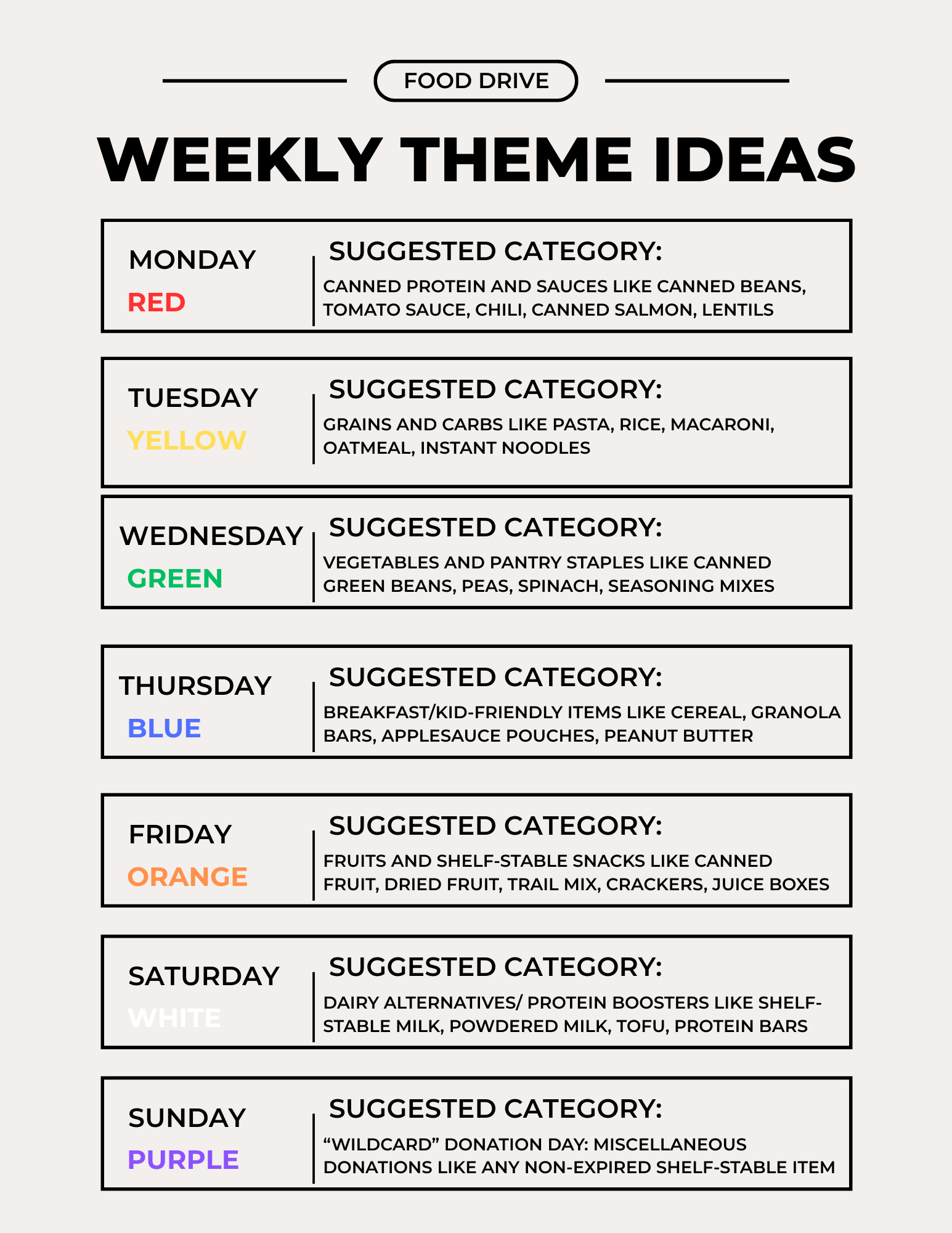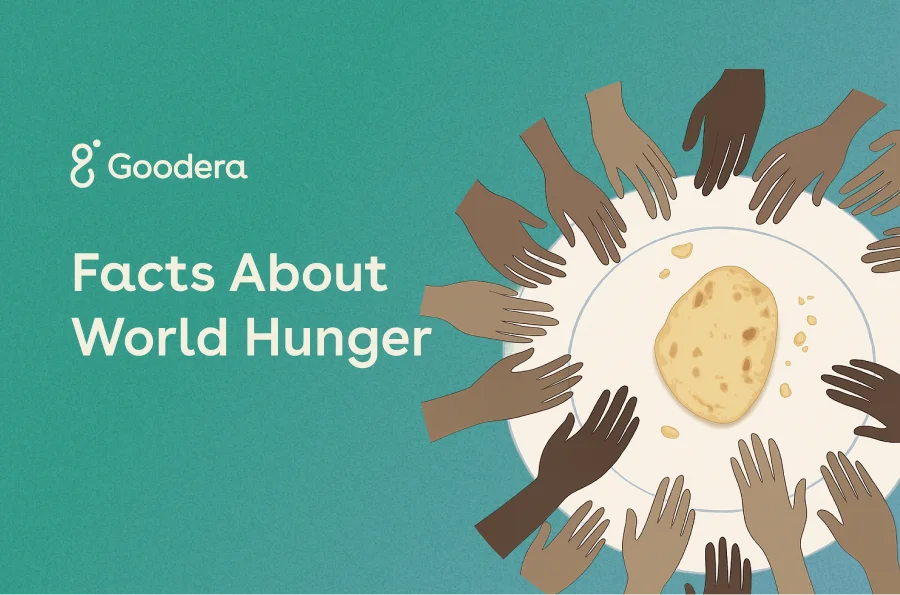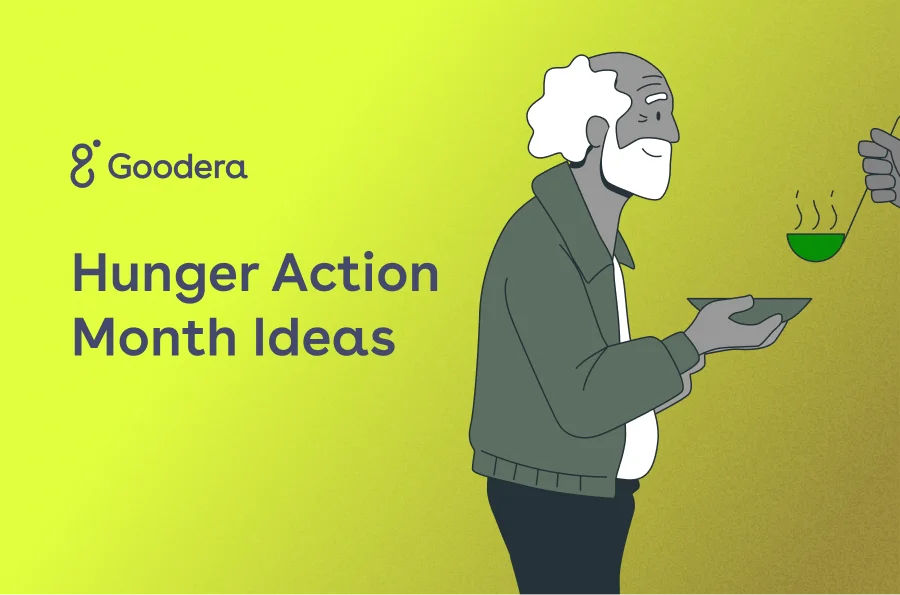Office Food Drive Ideas That Make a Real Difference
Food, or a roof over your head? School books for your child, or manage a meal for the night? These are impossible choices, but for millions, they’re a daily reality. Hunger doesn’t always look dramatic. Sometimes, it’s quietly skipping meals, stretching a bag of rice across a week, or watching your child eat while you go without.
Access to food not only means a full stomach, it also means hope, resilience, and the chance to thrive.
💡Did you know?
In 2024, an estimated 735 and 783 million experienced hunger worldwide, underscoring the urgent and growing challenge of global food insecurity.
But hunger is not inevitable. It’s a solvable crisis. And well-planned food drives are one of the simplest, most powerful ways to help.
When organizations like yours come together, the impact can be exponential. A single office food drive can put thousands of meals into the hands of people who need them most. With intention and empathy, your workplace can be a force for nourishment, dignity, and hope.

In this blog:
- What is a food drive?
- How to successfully organize a food drive?
- Food drive ideas for the office that actually work
- Donation ideas for food drive: learn what to donate
- Measuring your impact
What Is a Food Drive and Why Does It Matter?
A food drive is a collective effort to gather and donate non-perishable food items for people facing hunger. These drives are typically organized by schools, workplaces, community groups, or individuals who want to make a tangible difference.
At their core, food drives are a powerful reminder of what’s possible when communities come together, ensuring everyone has access to something as essential and life-affirming as food.
Even a small food drive can spark meaningful impact. Even modest food donations from businesses can have a powerful impact, helping reduce food waste, support local food pantries, and provide nutritious meals to those facing hunger.
According to the 2025 ReFED report, while the U.S. generates tens of millions of tons in surplus food each year, only a small portion is redirected to those in need. In 2023 alone, the country produced 47 million tons of surplus food, yet just 12% (around 1.75 million tons) was donated. This gap underscores a major opportunity for companies to step up. By optimizing food donation programs, organizations can play a pivotal role in reducing waste, fighting hunger, and driving meaningful environmental impact.
How do Food Drives Help Fight Hunger?
Food drives bridge the gap between abundance and need. While millions go hungry each day, tons of perfectly good food often go to waste. Food drives help reroute this surplus, whether from homes, offices, or supply chains, to local food banks and nonprofits that distribute it directly to those who need it most.
Beyond just meals, food drives offer consistency. They stock pantry shelves, support community kitchens, and ease the pressure on families facing tough choices between food and other essentials. When coordinated thoughtfully, even small-scale food drives can generate thousands of meals, reduce food waste, and restore a sense of dignity to those affected by hunger.
And the impact isn’t just local. Workplace food drives also help normalize conversations around food insecurity, inspire long-term giving, and mobilize entire teams around a cause that’s both urgent and solvable.
How to Organize a Food Drive at Work
Organizing a food drive at work might sound like a big task, but trust us, it’s totally doable and incredibly rewarding. With the right planning, clear communication, and a few thoughtful touches, your team can create a campaign that’s both impactful and easy to run.
💡Want a smoother experience? Goodera can handle everything for you. From planning your office food drive and managing logistics to creating outreach collateral and measuring impact. All you need to do is show up with your team, volunteer together, and make a difference while having fun along the way.
Here's a step-by-step guide to help you get started:
1. Decide what kind of food drive you want to host: Start by asking “what feels right for our team?” You could run a classic canned food drive, set up donation bins around the office, or even go digital with a virtual food drive. Keep your team’s preferences and schedules in mind.
2. Choose a local partner or food bank: Reach out to a local food bank or nonprofit and ask what they actually need. They’ll often share a wishlist of items, preferred donation windows, and helpful tips to make your drive more impactful.
Tip: Goodera has a global network of over 50,000 nonprofits that work across multiple cause areas. We can help map your food drive to any specific organizations or causes you want to work with.
3. Set your goals and timeline: How long will your drive run—one day, one week, a whole month? Will you measure success in pounds of food collected, number of team members who joined in, or total meals donated? Set a goal that feels both inspiring and realistic.
4. Rally your team and spread the word: Here’s where things get fun. Use email, Slack, posters, and even kickoff huddles to get your team excited. Share stories, stats, and visuals to help everyone connect with the cause. And don’t forget to assign point people or champions to keep up the momentum.
Good to know:
Volunteering champions are passionate employees who step up to lead and energize their teams during volunteering initiatives. Think of them as the bridge between your company’s CSR or HR teams and your broader workforce. They rally colleagues, spread the word, answer questions, and often help organize logistics on the ground.
5. Make it engaging and inclusive: Think about small touches that make the experience better—theme days (like "Protein Friday"), friendly team challenges, or sharing photos of everyone dropping off donations. If you are looking to engage a remote team, you can engage them in activities like collecting e-gift cards or raising funds for a food bank.
*We have discussed some interesting food drive ideas for the office in the section that follows.
6. Handle logistics with care: Place donation boxes in accessible, high-traffic areas across your office. Ensure any collected food is stored safely, especially if it’ll be out for a few days. Plan ahead for transportation and coordinate drop-off times with your nonprofit partner. Keep in mind, the type of food you collect will also influence how you store, sort, and deliver it.
7. Wrap it up with impact: After the drive, share the results, such as how much was collected, where it went, and the lives it touched. Post photos, give shoutouts, and make sure your team feels proud of what they achieved. It’s a reminder that small efforts multiplied by a team can spark something truly meaningful.
Planning is only half the journey. The real magic lies in how you bring your food drive to life, through themes, contests, and ideas that spark curiosity and connection. Let’s dive into food drive ideas that turn good intentions into real action.
Office Food Drive Ideas That Encourage Real Participation
A food drive doesn’t have to mean just stacking cans in a box. With the right approach, your office food drive can become something your whole team rallies behind. You could explore creative theme ideas to set the tone, plan engaging food drive contests for some healthy competition, or even bring in virtual and hybrid volunteering options to include remote employees.
The food drive ideas shared below are designed to help you do just that–make your drive feel exciting, inclusive, and impactful. From decorating collection bins to organizing friendly competitions, these ideas can spark joy while supporting a cause that matters deeply.
Creative Food Drive Themes to Inspire Participation
1. Colors of Kindness Week
Assign each day of the week a different color and match it with a category of food drive items. For example, Monday is Red Day (tomato sauces, canned beans), Tuesday is Yellow Day (pasta, rice), and so on. Teams can dress in that day's color, decorate bins accordingly, and donate matching items. It’s visual, playful, and keeps your drive top of the mind throughout the week.
Here’s a week-long food donation plan to get you started:

2. Meals in a Bag Challenge
Turn your food drive into a thoughtful team challenge by encouraging employees to create complete meal kits instead of donating single items. The idea is simple—build a themed meal-in-a-bag that includes everything someone would need to make a nourishing, delicious dish.
Examples:
- Pasta Night: Pasta, tomato sauce, Italian seasoning, canned veggies
- Breakfast on the Go: Cereal, shelf-stable milk, fruit cups, granola bars
- Taco Tuesday: Tortillas, canned beans, salsa, seasoning mix
Encourage teams to get creative with themes and presentations. You can even add a labeling station where volunteers write out what’s in each bag and include handwritten recipe cards, fun doodles, or notes of encouragement for the recipients.
To boost engagement, turn it into a friendly competition—award prizes for the most creative meal, best presentation, or most heartwarming note. You could even partner with a local restaurant or food app to offer free meal vouchers as prizes.
3. Superheroes Against Hunger
Unleash your team’s inner superheroes by turning your office food drive into a heroic mission to fight hunger. Encourage employees to “suit up”, literally or metaphorically, as everyday heroes making a real difference.
Set the tone with:
- A superhero dress-up day where people can wear capes, masks, or just a fun badge that says “Hunger Hero.”
- A themed donation station decorated like a superhero HQ, complete with comic-style posters and bold signage.
- A photo booth corner with props like masks, capes, and speech bubbles (“Bam!” “Zap Hunger!”) where teams can snap pictures as they drop off their food drive items.
Celebrate your champions:
- Use your internal Slack channels or email to give shoutouts to high-participation teams or individuals with the most thoughtful or creative food drive donations.
- Award daily or weekly titles like “Hero of the Day” or “Team Titan” to those who go the extra mile, whether by donating full meal kits, rallying others, or decorating their bins with flair.
You could even create a “Wall of Heroes” in a shared space or digital board with names and photos, making it visible who’s leading the charge. This adds a playful, team-building element while spotlighting your cause.
It's a fun, energizing way to get people excited, spark some friendly competition, and make your food drive feel like a true team mission.
4. Around the World Drive
Take your team on a culinary journey, without leaving the office! The Around the World Drive invites employees to explore global flavors while donating food items that reflect different cultures and cuisines.
Choose 3 to 5 cuisines—like Indian, Mexican, Italian, Middle Eastern, or East Asian—and assign each one to a day or station. For each cuisine, suggest a list of shelf-stable food drive items people can donate that reflect traditional flavors or staples. For example:
- Indian Day: lentils, rice, garam masala packets, shelf-stable curry sauces
- Mexican Day: canned beans, corn, tortillas, tomato sauce, spices
- Italian Day: pasta, canned tomatoes, Parmesan, pesto, herbs
- Middle Eastern Day: couscous, chickpeas, tahini, canned veggies
- East Asian Day: ramen noodles, soy sauce, canned tofu, jasmine rice
Make it immersive and inclusive:
- Set up decorated donation zones with mini flags, cultural décor, and info cards about the cuisine.
- Encourage teams to dress up or accessorize in a way that celebrates the culture being honored that day.
- Invite team members to share family recipes or cultural stories connected to the cuisine—this could be in a lunchroom display, internal newsletter, or virtual post.
You’ll be celebrating the rich diversity of your workplace while also encouraging more thoughtful and culturally relevant food drive donation ideas. This approach helps ensure your team’s contributions better reflect the communities you’re supporting, especially in multicultural areas where food banks often request ethnic staples.
5. Office Olympics: Can Edition
Turn your food drive into a high-spirited competition by hosting an Office Olympics—with canned goods as your currency! Assign each department or team a different “country” and let the games begin. Teams earn points for every food drive item they contribute, and bonus points can be awarded for themed costumes, creative bin decorations (think national flags or cultural icons), or participation in fun mini-challenges throughout the week.
Set up a central leaderboard in a shared office space—or a digital one for remote tracking—to keep motivation high and teams vying for the top spot. You can even host a closing ceremony with medals or prizes like lunch vouchers, casual dress days, or a team shoutout in your company newsletter.
This idea works because it turns giving into a game, adds a team-bonding element, and keeps your food drive top of mind all week long.
Hybrid and Virtual Food Drive Ideas
Just because your team isn’t all under one roof doesn’t mean your food drive has to feel disconnected. With a little creativity and the right tools, you can run an inclusive campaign that keeps remote and in-office employees equally engaged and makes a real impact.
Here are some hybrid-friendly food drive ideas to get you started:
1. Launch a Virtual Food Drive Platform
Instead of collecting physical food drive items, set up a virtual food drive through a local food bank or nonprofit partner. Employees can donate funds online, select food items from a digital pantry, or contribute toward meal kits that are delivered directly to families in need. It’s fast, flexible, and inclusive for remote teams.
📌 Pro tip: Track donations by team or department to gamify participation and offer small rewards or shoutouts for milestones hit.
2. Host a “Click-to-Give” Day
Designate a day where everyone, regardless of location, gets involved by donating a specific item virtually (e.g., “Protein Wednesday” or “Breakfast Friday”). You can coordinate with food banks that list urgent needs and set up direct donation links. Add a fun twist by encouraging team members to share what they would’ve brought physically, like a can of chickpeas or a favorite breakfast cereal.
3. Organize a Hybrid Drive-by Drop-off
For local employees, set up a few accessible, contactless drop-off locations (like your office parking lot or a partner site). Remote employees can mail in their food drive items using pre-labeled donation boxes or contribute via a gift registry. This creates a tangible sense of participation without excluding anyone.
4. Virtual Contests with a Cause
Bring the fun of office competitions to your virtual food drive with creative online contests that drive participation and amplify your impact even from afar.
You can launch a series of light-hearted challenges over the course of the drive, like:
- Most Creative Pantry Photo: Ask employees to take a fun photo of their food donation pile or pantry contribution—whether it’s a heart-shaped arrangement of canned goods, or a themed display like “Food Drive Fairy Tale.” Encourage costumes, props, or pets for bonus creativity points! Everyone votes for their favorite entry, and the winner receives a digital reward.
- Guess the Total Weight: Have a running tracker of how many pounds of food your team has donated so far. Let remote employees guess the final tally at the end of the drive. The closest guess wins a prize—like a company-branded snack box or lunch voucher.
- Theme Day Challenges: Host mini-challenges like “Color Match Monday,” where employees wear a color that matches the day's donation theme and post a selfie with a matching food item. Or try “Throwback Thursday,” where people share a nostalgic meal from childhood and donate its shelf-stable version.
Make it easy to participate using your company’s internal tools, like Slack channels, Google Forms, or shared photo boards. Use polls to let employees vote on winners, and shout them out during all-hands calls or newsletters. For prizes, consider offering options like e-gift cards, free lunch delivery, or letting winners choose the next donation theme.
These contests spark excitement, create the needed buzz around the food drive, and help remote employees feel connected to the mission and each other.
5. Remote Recipe Swap + Fundraiser
Pair your virtual food drive with a team-building activity: ask employees to share a favorite budget-friendly recipe and compile it into a digital “Cookbook for a Cause.” Tie it to a fundraiser where each recipe shared equals a dollar donated by your company or a matched contribution.
Food Drive Donation Ideas: What to Collect?
Not all donations are created equal. While every contribution is appreciated, some food drive items make a bigger impact, either because they’re highly requested by food banks or they help build complete, nutritious meals for families in need.
Below, we break down the best food drive donation ideas to guide your team’s giving. From pantry staples to thoughtful extras, these lists help ensure your food drive is not just generous, but genuinely useful to the communities you’re serving.
Food drive items that food banks need most
Most food banks have a consistent demand for the same core items—shelf-stable, nutritious, and versatile. Here are some of the most requested food drive items:
- Proteins: Canned tuna, salmon, chicken, peanut butter, beans (kidney, black, chickpeas), canned chili
- Whole Grains and Carbs: Brown rice, whole grain pasta, instant oats, granola bars, low-sugar cereals
- Canned Fruits and Vegetables: Low-sodium vegetables, tomato products, applesauce, fruit cups in juice (not syrup)
- Ready-to-Eat Meals: Canned soups and stews, mac and cheese, boxed meals, shelf-stable entrees
- Baby and Infant Needs: Baby formula, jars of baby food, toddler snacks, baby cereal (always check expiration dates)
- Other Essentials: Shelf-stable milk (tetra packs), cooking oil, spices, tea bags, instant coffee
💡Pro Tip: Always check with your local food bank for a preferred list of food drive items. Some may also need hygiene products or household goods.
What’s the best food to donate to a food bank?
Food banks typically prioritize donations that are shelf-stable, nutritious, and easy to prepare. The list below covers the kinds of food drive items that meet those needs, ensuring your team’s donations are both practical and impactful for the families who receive them.
- Shelf Life Matters: Opt for non-perishable items with long expiration dates—nothing frozen, fresh, or homemade.
- Think in Meals: Instead of random single items, try grouping donations that can form a complete meal (e.g., pasta, sauce, and canned veggies). This is where themed drives like "Pasta Night" or "Soup and Sides" come in handy.
- Nutrient-Dense and Low Sugar: Choose foods high in protein and fiber, and avoid heavily processed or sugary items when possible.
- Easy to Open and Use: Pull-tab cans and items that don’t require extra ingredients (like milk or eggs) are especially helpful for those without access to a full kitchen.
- Culturally Inclusive: Consider donating culturally relevant foods like lentils, rice noodles, canned curries, or spice mixes, especially if your drive is in a diverse community.
A well-stocked food drive is both generous and intentional. By donating food drive items that are needed most, you maximize your impact and help food banks better serve their communities.
Measuring Your Food Drive Impact: Tips to Track Success and Share Outcomes
Tracking the impact of your food drive helps you celebrate wins, recognize team contributions, and inspire future participation. Start by measuring the basics—total pounds of food collected, number of items, or meals provided. Many food banks can help convert your donations into meal equivalents or share how the items will be distributed.
Don’t stop at numbers. Capture the story behind your drive: share photos of decorated bins, highlight contest winners, and spotlight departments that went above and beyond. If you’re partnering with a food bank or nonprofit, ask for a thank-you message or stats you can pass along to your team. A simple visual recap can go a long way in reinforcing the difference you made together.
Creative ways to thank participants
Recognition turns participation into momentum. Whether your team donated a single can or organized a department-wide contest, showing appreciation helps people feel connected to the cause—and more likely to engage again.
You can thank participants with a mix of small gestures and big shoutouts:
- Create a digital appreciation wall with photos and names
- Give quirky awards like “Most Spirited Team” or “Best Bin Decor”
- Host a thank-you breakfast or virtual coffee chat
- Send handwritten thank-you notes from leadership or employee volunteers
- Highlight impact stories in your internal newsletter or Slack
A little gratitude goes a long way—make sure your team knows their efforts truly mattered.
Frequently Asked Questions
How do I host a local food drive with my team?
Start by partnering with a local food bank or nonprofit to understand their needs. Choose a timeline, designate collection points, and assign volunteer roles. Promote the drive across your internal channels and consider adding fun elements like themed days or donation contests to boost engagement.
What are the best food drive ideas for offices?
Some of the most effective office food drive ideas include theme-based donation days (like “Meals in a Bag” or “Color Days”), team-based donation contests, and creative activities like the “Office Olympics: Can Edition.” These help make participation fun, memorable, and team-focused.
Can remote employees participate in food drives?
Absolutely! Remote team members can donate directly through virtual food drives, contribute to Amazon wishlists curated by food banks, or fundraise for hunger relief nonprofits. You can also involve them in virtual contests, digital thank-you events, or hybrid volunteering experiences.
What food items should I donate to a food bank?
Shelf-stable, nutritious items with a long expiration date are best. Examples include canned proteins (beans, tuna), pasta, rice, canned vegetables and fruits, peanut butter, shelf-stable milk, and baby formula. Avoid perishable, expired, or opened food.
How do I make my food drive more impactful?
Choose a clear goal, keep communication fun and inclusive, and tie your efforts to real impact (like meals donated or families served). Use themes and contests to keep morale high and track your outcomes so you can celebrate success and recognize contributors meaningfully.











